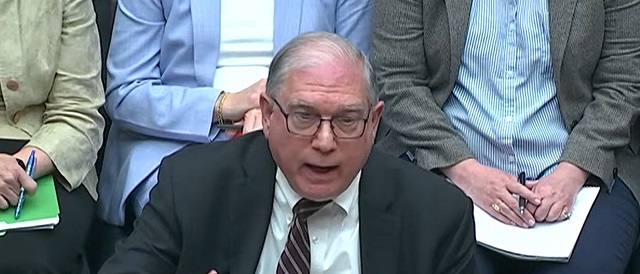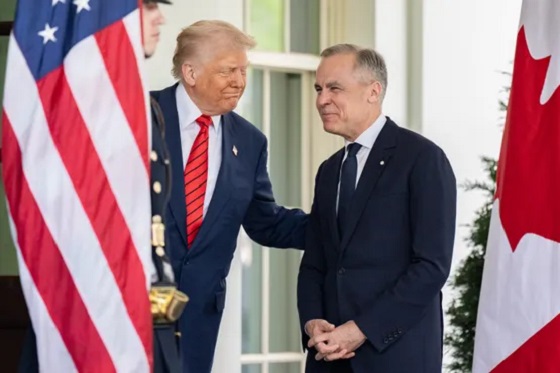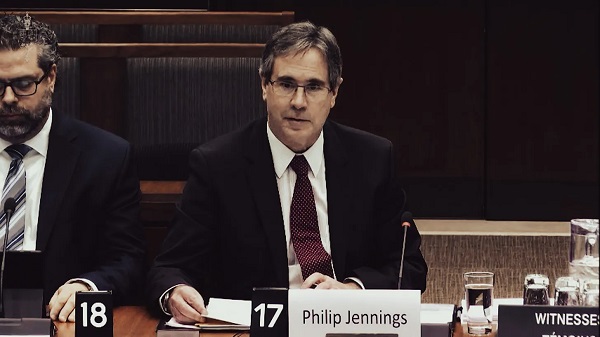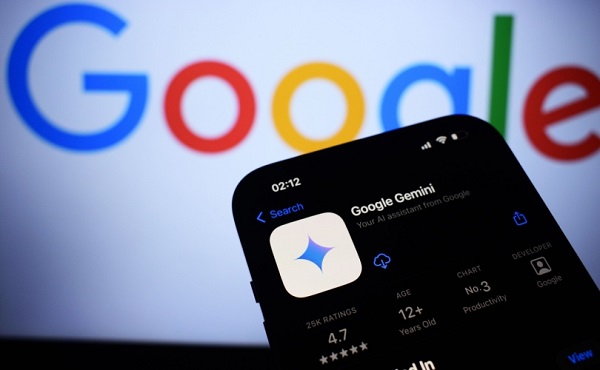COVID-19
House COVID Committee Confirms What We Have Long Suspected — The Feds Really Hate Transparency

 From the Daily Caller News Foundation
From the Daily Caller News Foundation
Last week details emerged from the House Select Subcommittee on the Coronavirus Pandemic, confirming what government transparency advocates long suspected: Federal bureaucrats are purposefully stonewalling the American people’s right to know about their government.
Republican Kentucky Rep. James Comer, who chairs the full House Oversight and Accountability Committee, read from an email that Dr. David Morens, a top aide to Dr. Anthony Fauci, sent claiming that a staffer inside the National Institutes of Health (NIH) had shown him how to erase records requested by the public.
He was corresponding with Peter Daszak, president of EcoHealth Alliance, the organization that used tax dollars to fund controversial gain-of-function research in Wuhan, where the COVID outbreak began. The Department of Health and Human Services has since suspended funding of EcoHealth Alliance.
Morens wrote: “I learned from our FOIA (Freedom of Information Act) lady here how to make emails disappear after I am FOIA’d, but before the search starts. So, I think we are all safe. Plus, I deleted most of those earlier emails after sending them to Gmail.”
The implications for government transparency are enormous. How often do NIH staffers conceal what they do with our tax dollars? Why did a FOIA officer feel empowered to assist subjects of FOIA requests? How else do FOIA offers interfere with these requests? Has this behavior spread to the Centers for Disease Control and other agencies?
Our auditors at OpenTheBooks.com can speak to the problem. We have spent years — and gone to court — to force NIH to reveal the royalties paid to government scientists through medical innovation licensing.
When Americans are considering a drug or therapeutic recommended by public health officials, they deserve to understand all the financial stakes at play. Were any decision makers receiving payments? Were they continuing more lucrative research at the expense of other public health solutions?
For many, the question looming largest has been whether the relentless COVID vaccine push was driven by a potential windfall for NIH and certain scientists there.
When we first filed a FOIA, the agency ignored us and then refused to release the information.
After suing, NIH was required to release the information and began doing so incrementally due to the high volume of data. Tallied from 2009 through 2020, it amounted to an enormous sum–over $325 million paid by private companies to NIH and its scientists over 56,000 transactions.
Previously, we’d also discovered that Dr. Fauci, the face of the nation’s COVID response, was the highest compensated bureaucrat in the country. He out-earned President Biden. He out-earned his own boss, then-Acting NIH Director Lawrence Tabak.
Along with Fauci, who scoffed at concerns about royalty payments, Tabak faced questions from Congress.
In a March 2023 budget hearing, Rep. John Moolenaar told Tabak an obvious truth: every single, secret royalty payment represents a potential conflict of interest.
“To me, one of the biggest concerns people had during this last couple years is: Were they getting truthful information from their government? Could they trust what people were saying about the medicines? To me, that creates a very disturbing appearance.”
“The idea that people were getting a financial benefit from certain research that was done and grants that were awarded, that to me is the height of the appearance of a conflict of interest,” Moolenaar concluded.
The lawmaker urged NIH to make the money trail more transparent.
It was Tabak in the hot seat again last week, as Comer recited Morens’ outrageous email message.
Was the behavior he described consistent with NIH policy, Comer asked? “It is not,” Tabak responded flatly.
Did the FOIA team at NIH help its colleagues avoid transparency? “I certainly hope not,” Tabak offered.
Hope doesn’t suffice in this situation. It demands that lawmakers strengthen transparency law, update it for the 21st century and create some consequences for bad actors.
There are a few primary ways bureaucrats and decisionmakers violate the spirit of the law.
First, they overuse a series of exemptions designed to protect national security secrets or privacy laws. Too much is omitted through these exceptions; the American people deserve the full truth.
When documents are produced, they’re too often rendered useless through excessive redactions. We’re still fighting in real time to get more pieces of the royalty puzzle revealed.
Next, unreasonable delays are blamed on staffing levels, while many FOIA-related roles sit open. Agencies must prioritize filling those seats and Congress should appropriate more of them as needed.
Finally, we have the behavior Morens describes. A post facto effort to simply abscond with the information. It’s not just a policy violation but an affront to the spirit of the Freedom of Information Act. What consequences do these staffers ever truly face?
Until we get serious about protecting transparency, “FOIA lady” will be a duly anonymous symbol of what many have suspected: government employees hustling to cover their tracks.
Adam Andrzejewski is founder & CEO of OpenTheBooks.com, the nation’s largest private database of public spending.
COVID-19
The dangers of mRNA vaccines explained by Dr. John Campbell

From the YouTube channel of Dr John Campbell
There aren’t many people as good at explaining complex medical situations at Dr. John Campbell. That’s probably because this British Health Researcher spent his career teaching medicine to nurses.
Over the last number of years, Campbell has garnered an audience of millions of regular people who want to understand various aspects of the world of medical treatment.
In this important video Campbell explains how the new mRNA platform of vaccines can cause very serious health outcomes.
Dr. Campbell’s notes for this video:
Excess Deaths in the United Kingdom: Midazolam and Euthanasia in the COVID-19 Pandemic https://www.researchgate.net/publicat… Macro-data during the COVID-19 pandemic in the United Kingdom (UK) are shown to have significant data anomalies and inconsistencies with existing explanations. This paper shows that the UK spike in deaths, wrongly attributed to COVID-19 in April 2020, was not due to SARS-CoV-2 virus, which was largely absent, but was due to the widespread use of Midazolam injections, which were statistically very highly correlated (coefficient over 90%) with excess deaths in all regions of England during 2020. Importantly, excess deaths remained elevated following mass vaccination in 2021, but were statistically uncorrelated to COVID injections, while remaining significantly correlated to Midazolam injections. The widespread and persistent use of Midazolam in UK suggests a possible policy of systemic euthanasia. Unlike Australia, where assessing the statistical impact of COVID injections on excess deaths is relatively straightforward, UK excess deaths were closely associated with the use of Midazolam and other medical intervention. The iatrogenic pandemic in the UK was caused by euthanasia deaths from Midazolam and also, likely caused by COVID injections, but their relative impacts are difficult to measure from the data, due to causal proximity of euthanasia. Global investigations of COVID-19 epidemiology, based only on the relative impacts of COVID disease and vaccination, may be inaccurate, due to the neglect of significant confounding factors in some countries. Graphs April 2020, 98.8% increase 43,796 January 2021, 29.2% increase 16,546 Therefore covid is very dangerous, This interpretation, which is disputable, justified politically the declaration of emergency and all public health measures, including masking, lockdowns, etc. Excess deaths and erroneous conclusions 2020, 76,000 2021, 54,000 2022, 45,000 This evidence of “vaccine effectiveness” was illusory, due to incorrect attribution of the 2020 death spike. PS Despite advances in modern information technology, the accuracy of data collection has not advanced in the United Kingdom for over 150 years, because the same problems of erroneous data entry found then are still found now in the COVID pandemic, not only in the UK but all over the world. We have independently discovered the same UK data problem and solution for assessing COVID-19 vaccination as Alfred Russel Wallace had 150 years ago in investigating the consequences of Vaccination Acts starting in 1840 on smallpox: The Alfred Russel Wallace as used by Wilson Sy “Having thus cleared away the mass of doubtful or erroneous statistics, depending on comparisons of the vaccinated and unvaccinated in limited areas or selected groups of patients, we turn to the only really important evidence, those ‘masses of national experience’…” https://archive.org/details/b21356336… Alfred Russel Wallace, 1880s–1890s 1840 Vaccination Act Provided free smallpox vaccination to the poor Banned variolation Vaccination compulsory in 1853, 1867 Why his interest? C 1885 The Leicester Anti-Vaccination demonstrations (1885) Growing public resistance to compulsory vaccination Wallace’s increasing involvement in social reform and statistical arguments Statistical critique of vaccination Government data on: Smallpox mortality trends before and after compulsory vaccination Case mortality rates Vaccination vs. sanitation effects Mortality trends before and after each Act, 1853 and 1867 “Forty-Five Years of Registration Statistics, Proving Vaccination to Be Both Useless and Dangerous” (1885) “Vaccination a Delusion; Its Penal Enforcement a Crime” (1898) Contributions to the Royal Commission on Vaccination (1890–1896) Wallace argued: Declining smallpox mortality was due to improved sanitation, not vaccination Official statistics were misinterpreted or biased Compulsory vaccination was unjust Re-vaccination did not reliably prevent outbreaks These views were strongly disputed, then and now. Wallace had a strong distrust of medical authority He and believed in: Statistical reasoning Social reform Opposition to coercive government measures The primacy of environmental and sanitary conditions in health
COVID-19
FDA says COVID shots ‘killed’ at least 10 children, promises new vaccine safeguards

From LifeSiteNews
“This is a profound revelation. For the first time, the US FDA will acknowledge that COVID-19 vaccines have killed American children”
At least 10 children have died because of the COVID shots, according to a recently publicized email from Trump Food and Drug Administration (FDA) officials.
“At least 10 children have died after and because of receiving COVID-19 vaccination,” FDA Chief Medical Officer Vinay Prasad wrote on Friday in an email to staff, obtained by The Daily Caller.
“This is a profound revelation. For the first time, the US FDA will acknowledge that COVID-19 vaccines have killed American children,” Prasad said in the memo.
The finding corroborates that of the Centers for Disease Control and Prevention (CDC), which recently linked at least 25 pediatric deaths to the COVID shot, via information from the Vaccine Adverse Event Reporting System (VAERS). Both counts likely significantly underestimate the real number of pediatric deaths from the shots, considering that studies have found vaccine injuries have been seriously underreported to VAERS.
In his Friday memo, Prasad ripped the Biden administration for pressuring the injection of these experimental mRNA shots into children.
“Healthy young children who faced tremendously low risk of death were coerced, at the behest of the Biden administration, via school and work mandates, to receive a vaccine that could result in death,” wrote Prasad.
“In many cases, such mandates were harmful. It is difficult to read cases where kids aged 7 to 16 may be dead as a result of covid vaccines.”
The disturbing admission by the Trump administration’s health agency highlights the silence of the Biden administration about these deaths and raises further questions about its integrity or lack thereof.
“Why did it take until 2025 to perform this analysis, and take necessary further actions? Deaths were reported between 2021 and 2024, and ignored for years,” wrote Prasad. He acknowledged that the vaccines potentially killed more children on balance, considering that they had virtually no risk of dying from COVID.
“The truth is we do not know if we saved lives on balance,” he wrote. “It is horrifying to consider that the US vaccine regulation, including our actions, may have harmed more children than we saved. This requires humility and introspection.”
The Center for Biologics Evaluation and Research (CBER) will reportedly strengthen its safety protocols for vaccines, including by requiring more clinical trials as opposed to relying on antibody laboratory studies, modifying the annual flu vaccine release, and examining the effect of administering multiple vaccines in one round.
This year, the CDC removed COVID shots from its recommended “vaccines” for healthy children. A CDC panel had voted in 2022 to add the COVID shots to the childhood immunization schedule despite their experimental nature and the fact that they were produced in a fraction of the time ordinarily required to bring a vaccine to market.
The push for COVID shots for children was spearheaded at least in part by CBER Director Peter Marks, who pushed for full approval of the COVID shots even for the young and healthy and laid the foundation for COVID shot mandates.
A large, growing body of evidence shows that the mRNA shots were dangerous to human health in a wide variety of ways and caused deaths at a rate far exceeding usual safety standards for vaccines. As Dr. Mary Talley Bowden, an ear, nose and throat specialist in Houston, Texas, explained to Tucker Carlson in April:
Normally, the FDA will put a black box warning on a medication if there have been five deaths. They will pull it off the market if there have been 50. Well, according to VAERS, (the) Vaccine Adverse Event Reporting System – and it’s vastly under-reported, which I have seen firsthand – there have been 38,000 deaths from these COVID shots.
That number has since increased, according to VAERS, which now reports 38,773 deaths, 221,257 hospitalizations, 22,362 heart attacks, and 29,012 cases of myocarditis and pericarditis due to the COVID shot as of August 29, among other ailments.
-

 Alberta2 days ago
Alberta2 days agoAlberta will defend law-abiding gun owners who defend themselves
-

 National2 days ago
National2 days agoCanada Needs an Alternative to Carney’s One Man Show
-

 Alberta1 day ago
Alberta1 day agoThis new Canada–Alberta pipeline agreement will cost you more than you think
-

 MAiD1 day ago
MAiD1 day agoFrom Exception to Routine. Why Canada’s State-Assisted Suicide Regime Demands a Human-Rights Review
-

 Business1 day ago
Business1 day agoNew Chevy ad celebrates marriage, raising children
-

 Business23 hours ago
Business23 hours agoCarney government should privatize airports—then open airline industry to competition
-

 Great Reset2 days ago
Great Reset2 days agoCanada’s MAiD (State Sanctioned Murder) Report Just Dropped
-

 Automotive1 day ago
Automotive1 day agoPower Struggle: Governments start quietly backing away from EV mandates






